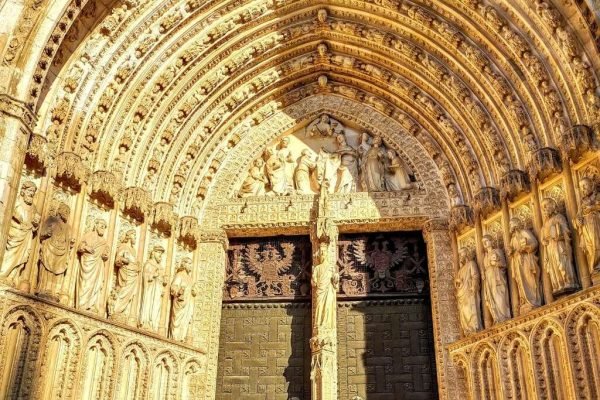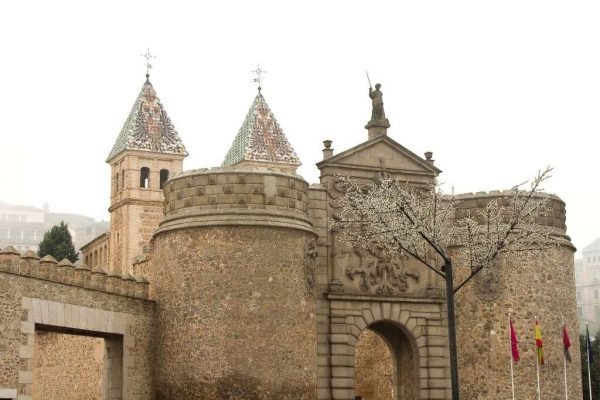Full-day coach trip Toledo from Madrid
PEPE TOURS
Full-day coach trip Toledo from Madrid
PEPE TOURS
Daytrip to Toledo from Madrid with English speaking guides
Toledo full day coach trip from Madrid. Very close to Madrid lies the Imperial City of Toledo, declared by UNESCO as a World Heritage Site in 1986 in recognition of so many centuries of history. We offer you a unique experience, visiting the famous “city of the three cultures”, its streets were synonymous with coexistence between Jews, Moors and Christians and its old town preserves the layout it had in the Middle Ages.
Tour accompanied by official tourist guides who will explain the city’s history, monuments, characteristics and customs, driven in modern, air-conditioned coaches. Departure from our terminal to Toledo, a museum city of great artistic beauty, which was the capital of the country and one of the oldest cities in Europe. Upon arrival, we take a panoramic tour by bus to enjoy the magnificent view of the city from the other side of the Tagus River, a must-see stop to take the most popular photo of Toledo. Next, we’ll visit a damascening workshop, where we’ll observe this traditional Toledo craft technique. Then, accompanied by a local expert guide, we’ll take a walking tour through Toledo’s historic centre to get a first impression of this imposing medieval city and take note of its most iconic landmarks. This introduction will help you explore further on your own later.
We’ll visit Plaza Zocodover, the city’s most emblematic square, surrounded by buildings in styles ranging from Renaissance to Baroque. We’ll then pass by the Alcazar of Toledo, a majestic fortress that today houses the Army Museum. Wandering through Toledo’s narrow streets, we’ll arrive at Plaza del Ayuntamiento (Townhall Square), where we’ll admire the façade of Toledo Cathedral, officially known as the Primate Cathedral of Spain. It is a stunning structure blending Gothic, Renaissance, and Baroque styles, built atop the foundations of an ancient mosque. For those who wish to enhance their experience in Toledo, we offer, together with the official guide, a complete exterior and interior visit of the Primate Cathedral, whose architecture reflects all stages of Spanish Gothic and houses numerous works of art: stained-glass windows, choir, main chapel, altarpieces, and paintings by El Greco, one of the most famous artists associated with Toledo.
After the visit, you’ll have free time in the city to enjoy lunch and shop for souvenirs on the well-known Calle Comercio, a pedestrian street filled with shops, restaurants, and bars, offering a wide variety of local products – from traditional sweets to Toledo crafts such as swords and damascening.
We recommend exploring the Jewish Quarter of Toledo, one of the city’s most emblematic and charming neighbourhoods, a place full of history and tradition that reflects the city’s rich multicultural past. This quarter is characterized by narrow cobbled streets, winding alleys, and houses with beautiful wrought iron balconies, giving it a picturesque and mysterious atmosphere.
You’ll be able to visit the Synagogue of El Transito, a gem of Mudéjar architecture and one of the best-preserved examples of Jewish history in Spain. Inside, you’ll find the Sephardic Museum, which houses a collection of objects that illustrate the history and culture of the Jewish people in the Iberian Peninsula.
Just a few steps away, you can also visit the Church of Santo Tome, famous for housing El Greco’s masterpiece, The Burial of the Count of Orgaz. Calle de la Judería is another main street running through this quarter, home to local craft shops and restaurants serving traditional dishes from Toledo’s rich cuisine.
At the indicated time, return to the meeting point to board the coach back to Madrid. Arrival and end of services.
Departure days:
Friday, Monday, Saturday, Sunday, Thursday, Tuesday, Wednesday
The excursion to Toledo includes:
– Roundtrip transportation by bus from Madrid to Toledo with official guide
– Panoramic tour by bus
– Guided walking tour of the old town
– Entrance and visit to the Primate Cathedral of Toledo (only option with cathedral)
– Accompanying guide throughout the trip
– Travellers insurance
PRICE PER PERSON IN EUROS (SEASON 2025 - 2026)
| PRICE PER PERSON IN EUROS (SEASON 2025 - 2026) | |
| ADULT | from 49 € |
| CHILD (3 – 11 years) | from 20 € |
More information about Toledo
The Imperial City of Toledo, in 1986 recognized as World Heritage by the UNESCO, is situated at only 60 kilometres of the capital of Madrid. At present several relics of the three cultures that lived amongst its walls remain, like the Prime Cathedral, the Mosque “Cristo de la Luz”, the Synagogue “del Transito”, the Alcazar and the celebration of Corpus Christi, one of the most important and popular processions in Spain.
The different people that passed through Toledo have left successively their footprints on the town. The walls for example, that were built by the Romans, were reconstructed and received their actual trace by the Arabs. Many gates can be found, but the gate “de la Bisagra” which carries in its upper part the coat of arms of the Imperial City, is the most representative and gives access to the historic town.
Mosque “Cristo de la Luz” (10th century). The only one of its style that survives of the ten that used to exist in the town. It is situated directly behind the gate of Bisagra, the horse-shoe arches succeed themselves and remember and are based on the Mosque of Cordoba.
Synagogue “del Transito” (14th century). Beautiful walls covered with plasterwork precede a rectangular interior, covered with a beautiful “alfarje” (panelled ceiling). It contains the Sefardi Museum.
The Cathedral. Of gothic style, it was erected between 1226 and 1493 on a west-gothic church, which was constructed during the reign of Recaredo. The sacristy harbours a valuable collection of paintings by El Greco, Lucas Jordan, Van Dijck and Goya. But all dependencies are works of art: from the Chapel of the New Kings to the Chapel of Santiago, along the Choir in Renaissance style, the Mozarabic Chapel or the Chapter House.
House Museum of El Greco. Although a sign indicates the entrance, the painter never lived here, but it does harbour several significant paintings of the artist from Crete, such as the Tears of Saint Peter or The Apostolate.
Alcazar of Toledo. Situated on the highest point of the town, in the Roman period it was a palace and under the Christians it was converted in to the first alcazar with a square base. Under Charles I it suffered an important remodelling. Each façade is of a different style and period: the eastern one is medieval, the western one is Renaissance, the northern one is Plateresque and the southern one is Churrigueresque (a Spanish Baroque style of elaborate sculptural architectural ornament). With the invasion of the French troops and the Spanish Civil War is was destructed, butter after the reconstruction it harbours the Museum of the Army and military units.
A period and a history go together in the handicraft: the swords from Toledo, the ceramics or the “damasquinado”. The production of swords and sables is destined mainly to tourism, although there are orders from different armies in the world. Regarding the damasquinado, this is an Arabian decoration technique, consisting of incrusting silver and gold on less noble but harder materials (iron, bronze, steel, ceramic, porcelain…) and applying this technique on rings, bracelets, brooches, dishes. All the streets are full with workshops and shops dedicated to handicraft which will not remain unobserved by visitors and convert some spaces in little bazaars.
Please note that
Exceptionally, the itinerary and the order of the excursions could be altered and modified for organizational reasons.








